AUDI Q7 2013 Owner´s Manual
Manufacturer: AUDI, Model Year: 2013, Model line: Q7, Model: AUDI Q7 2013Pages: 348, PDF Size: 87.72 MB
Page 251 of 348
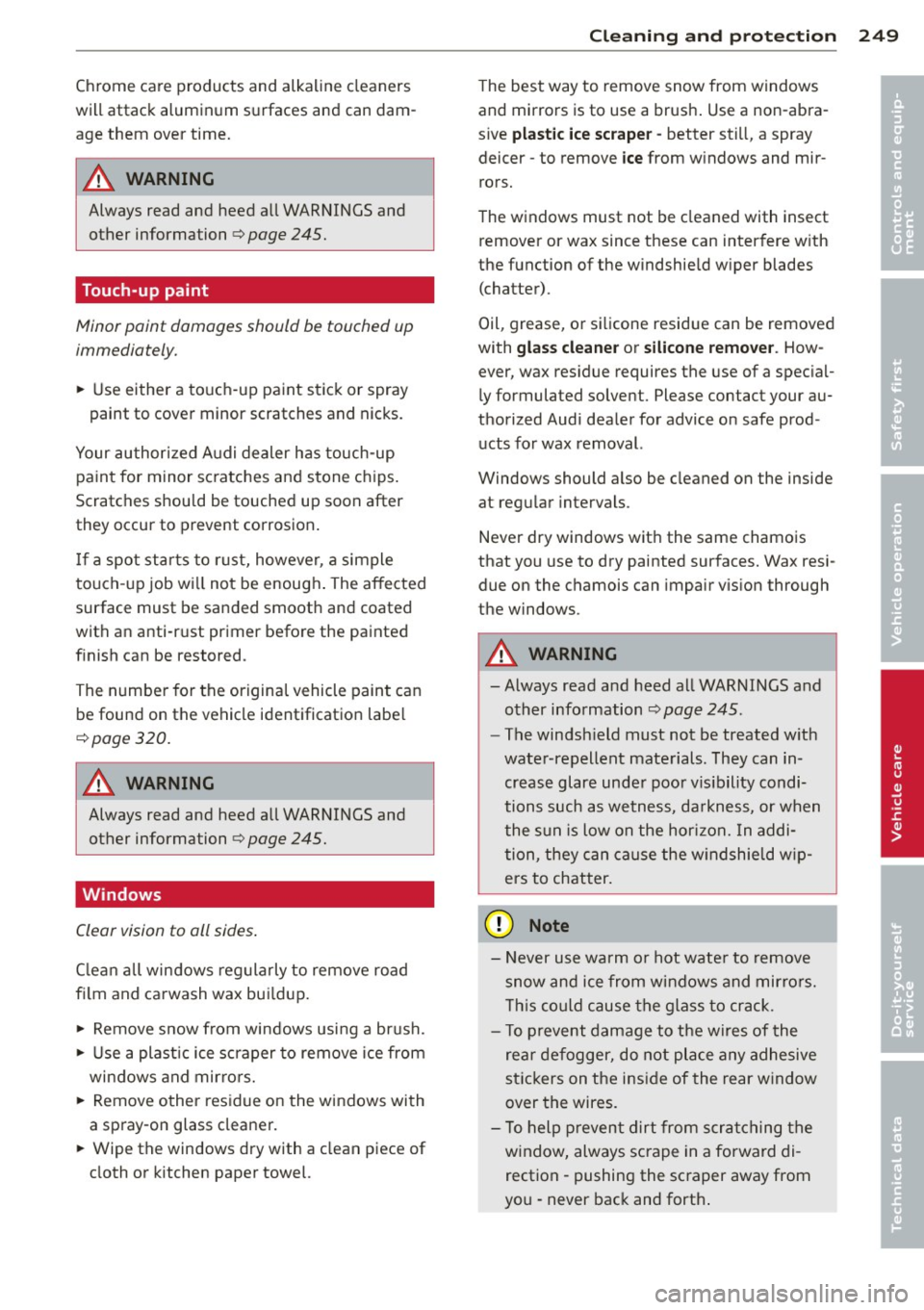
Chrome care products and alkaline cleaners
will attack aluminum surfaces and can dam
age them over time.
A WARNING
Always read and heed all WARNINGS and other information ¢
page 245.
Touch-up paint
Minor paint damages should be touched up
immediately.
.. Use either a touch-up paint st ick or spray
paint to cover minor scratches and nicks.
Your authorized Audi dealer has touch-up paint for minor sc ratches and stone chips.
Scratches should be touched up soon after
they occur to prevent corrosion .
I f a spot starts to rust, however , a simple
touch -up job wi ll not be enough . The affected
surface must be sanded smooth and coated
with an anti-r ust primer before the painted
finish can be restored.
The number for the origina l vehicle paint can
be found on the vehicle identification labe l
¢page 320.
A WARNING
Always read and heed a ll WARNINGS and
other information ¢
page 245.
Windows
Clear vision to all sides .
Clea n all windows reg ularly to remove road
fi lm and carwash wax bui ldup.
.,. Remove snow from windows using a brush.
.. Use a plast ic ice scraper to remove ice from
windows and mirro rs.
.. Remove other residue on the windows with
a spray-on glass cleaner.
.. Wipe th e windows dry with a clean piece of
cloth or kitchen paper towel.
Cleaning and protec tion 249
The best way to remove snow from windows
and mirrors is to use a brush . Use a non-abra
s ive
pl astic ice scrape r -better sti ll, a spray
deicer -to remove
ice from w indows and mir
rors.
The windows must not be cleaned with insect remover or wax since these can interfere w ith
the function of the windshie ld w iper blades
(chatter) .
Oil, grease, or s ilicone residue can be removed
with
gla ss cle ane r or s ilicone remo ve r. How
ever, wax re sidue requires the use of a spec ial
ly formulated solvent. Please contact your au
thorized Audi dea ler for advice on safe prod
ucts for wax removal.
Windows should also be cleaned on the inside
at regu lar in tervals .
Never dry windows w ith the same chamois
that you use to dry painted surfaces. Wax resi due on the chamois can impair v is ion through
the windows .
A WARNING
-Always read and heed all WARNINGS a nd
other information ¢
page 245.
-The windsh ield must not be treated w ith
water -repellent materials . They can in
crease glare unde r poor v is ibility condi
tions such as wetness, da rkness, or when
the sun is low on the hor izon. In addi
tion, they can ca use the w indshield w ip
ers to chatter.
(D Note
- Never use warm o r hot wate r to remove
s now and ice from windows and mirro rs.
T his could cause the glass to crack .
- To prevent damage to t he w ires of the
rear defogger, do not place any adhesive
st ic kers on the ins ide of the rear w indow
over the wires.
- To help prevent d irt from scra tching the
w indow, always scrape in a forward di
rection -pushing the sc ra per away from
you -never back and forth .
•
•
Page 252 of 348
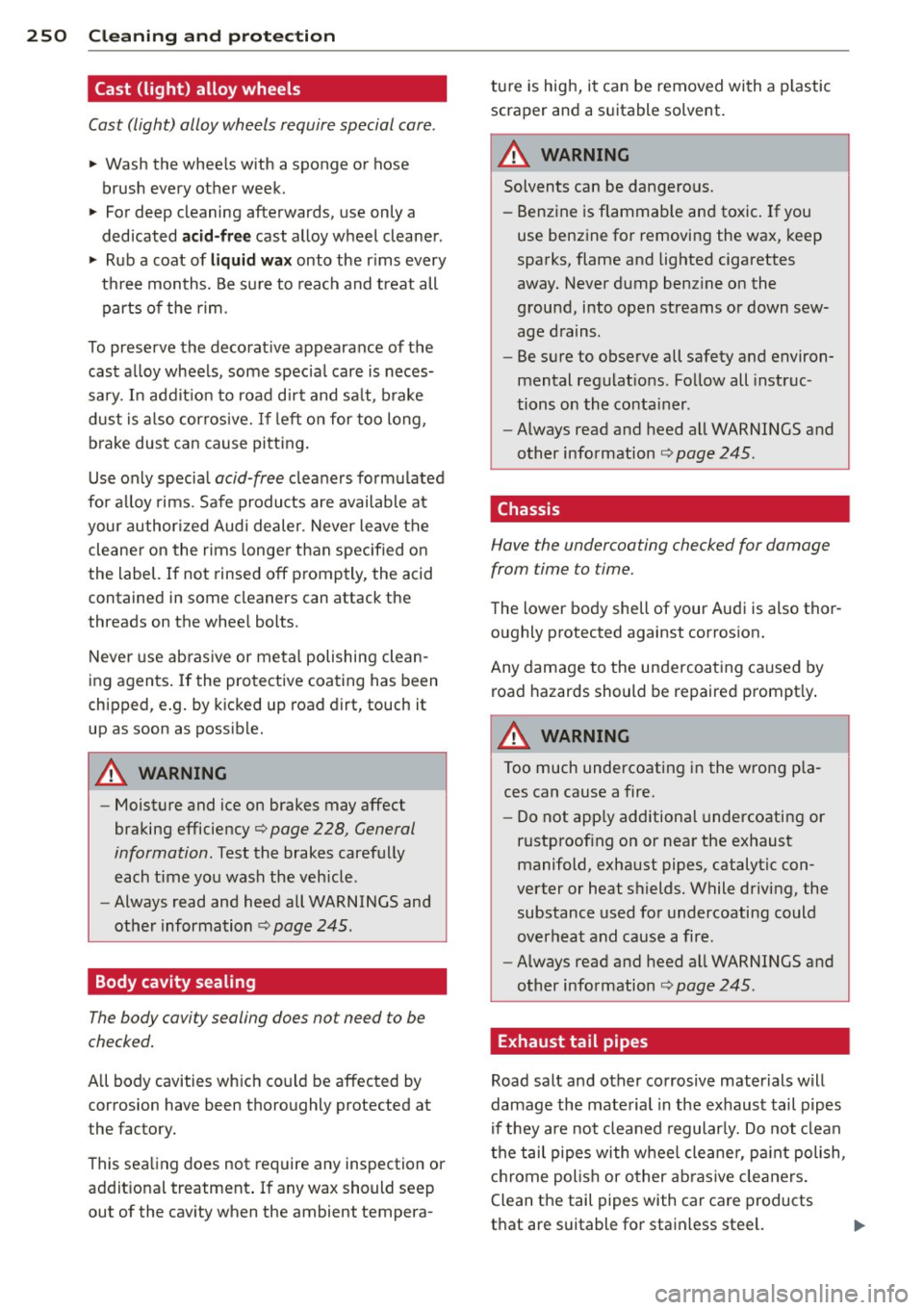
250 Cleaning and protec tio n
Cast (light) alloy wheels
Cast (light) alloy wheels require special care .
• Wash the whee ls with a sponge or hose
brush every other week.
• For deep cleaning afterwards, use only a
dedicated
aci d-fr ee cast alloy wheel cleaner .
• Rub a coat of
liq uid wax onto the r ims every
t h ree months. Be su re to reach and treat all
parts of the rim .
To preserve the decorat ive appearance of the
cast alloy whee ls, some specia l care is neces
sa ry. In addit ion to road dirt and sa lt, b rake
d ust is a lso corros ive. If left on for too long,
b rake dust can cause pitting.
Use only specia l
acid-free cleaners formulated
for a lloy rims . Safe p roducts are available at
your author ized Audi dealer. Never leave the
cleane r on the rims longe r than specified on
the label. If not rinsed off promptly, the acid
contained in some cleaners can attack the
threads on the whee l bolts.
Never use ab rasive or metal polishing clean
ing agents. If the protective coating has been
chipped, e .g. by k icked up road dirt, touch it
up as soon as possible.
A WARNING
- Moisture and ice on brakes may affect
braking efficiency¢
page 228, General
information.
Test the brakes carefully
each time you wash the veh icle .
- Always read and heed all WARNINGS and
other information
¢ page 245.
-
Body cavity sealing
The body cavity sealing does no t need to be
checked.
A ll body cavities which co uld be affected by
corrosion have been thoro ughly protected at
the factory.
This sealing does not require any inspection or
addit ional treatment . If any wax should seep
out of the cav ity when the ambient tempera- ture is high, it can be removed with a p
lastic
scraper and a suitable solvent.
A WARNING
-Solvents can be dangerous.
- Benzine is flammab le and toxic. If you
use benzine for removing the wax, keep
sparks, flame and lighted cigarettes
away. Never dump benz ine on the
ground, into open streams or down sew
age drains.
- Be sure to observe all safety and environ
mental regulat ions . Follow all instruc
tions on the container .
- Always read and heed all WARNINGS and
other information ¢
page 245.
, Chassis
Have the undercoating checked for damage
from time to time.
The lower body shell of your Audi is also thor
oughly protected against corros ion.
Any damage to the undercoating caused by road hazards should be repaired prompt ly .
A WARNING
Too much undercoating in the wrong p la
ces can cause a fire.
- Do not app ly additional undercoating or
r u stproof ing on or near the exhaust
manifold, exhaust pipes, catalytic con
verter or heat shields. While driving, the substance used for undercoating could
overheat and cause a fire.
'
- Always read and heed all WARNINGS and
other information ¢
page 245.
Exhaust tail pipes
Road salt and other corrosive materials will
damage the material in the exhaust tail pipes
if they are not cleaned regularly. Do not clean
the tail pipes with wheel cleaner, pa int polish,
chrome polish or other ab rasive cleaners.
Clean the tail pipes with car care products
that are suitable for stainless steel.
Page 253 of 348
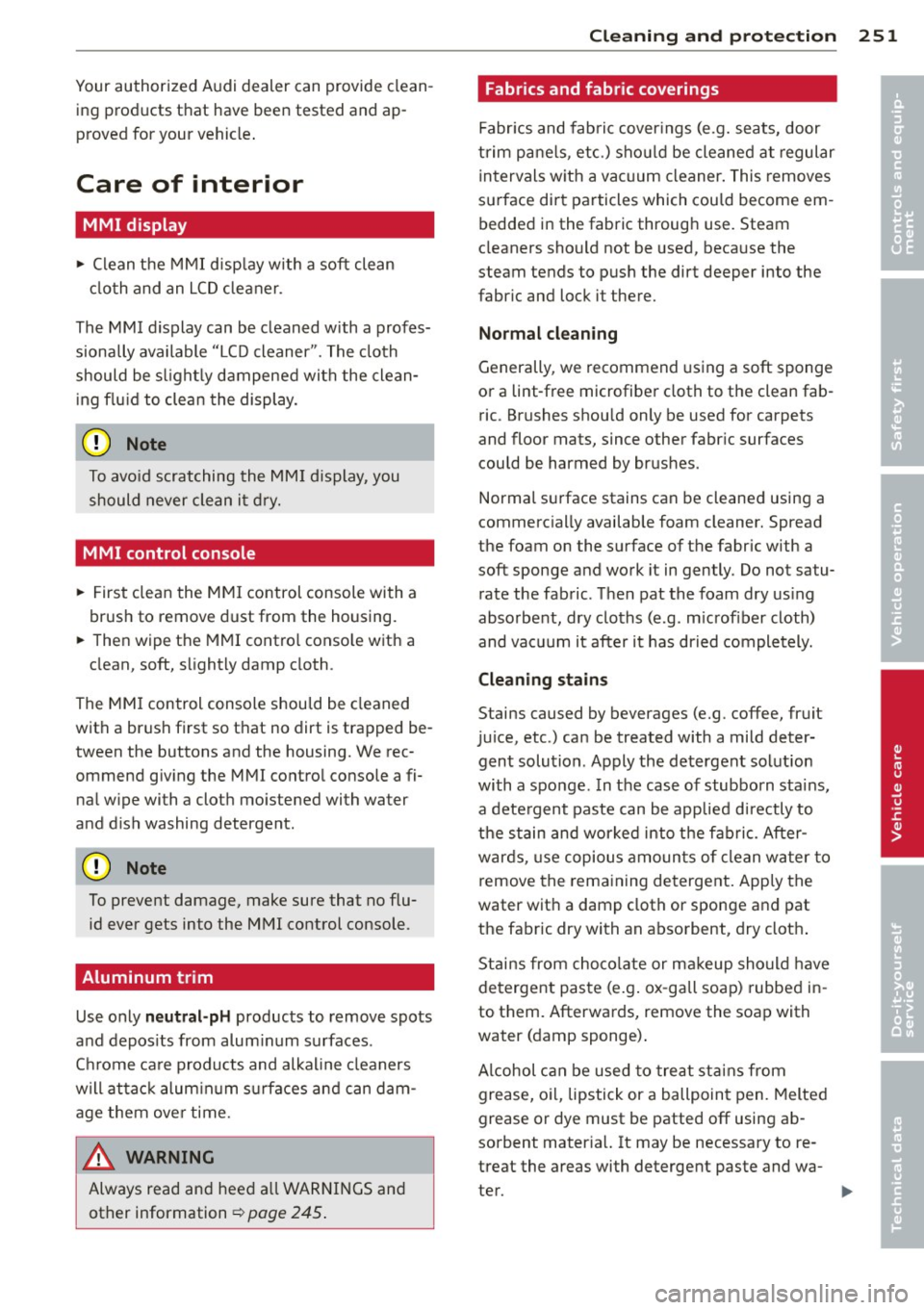
Your authorized Audi dealer can provide cleaning products that have been tested and ap
proved for your vehicle .
Care of interior
MMI display
"' Clean the MMI disp lay with a soft clean
cloth and an LCD cleaner .
The MMI display can be cleaned with a profes sionally available "LCD cleaner". The cloth
should be s light ly dampened with the clean
ing f lu id to clean the display.
(D Note
To avo id scratching the MM I display, you
should never clean it d ry.
MMI control console
"' First clean the MMI control console with a
brush to remove dust from the housing.
"' Then wipe the MMI contro l conso le with a
clean, soft, slightly damp cloth .
The MM I control console shou ld be cleaned
with a brush first so that no dirt is trapped be
tween the buttons and the housing. We rec ommend giv ing the MMI control console a fi
nal w ipe with a cloth mo istened with water
and d ish washing detergent.
Cl) Note
To prevent damage, make sure that no flu id ever gets into the MMI control console.
Aluminum trim
Use only neutral-pH products to remove spots
and depos its from alum inum surfaces .
C hr ome ca re produ cts and alkaline cleaners
will attac k alum in um s urfaces and can dam
age them ove r time.
A WARNING
Always read and heed a ll WARNINGS and
other information
~ page 245 .
Cleaning and protec tion 25 1
Fabrics and fabric coverings
Fabr ics and fab ric cover ings (e.g. seats, door
trim pa ne ls, etc.) sho uld be cleaned at regular
intervals w ith a vacuum cleaner . This removes
s u rface dirt particles which could become em
bedded in the fabric throug h use. Steam
cleaners should not be used, because the
steam tends to push the dirt deeper into the
fabric and lock it there.
No rmal cl ean ing
Generally, we recommend using a soft sponge
or a lint-free microfiber cloth to the clean fab ric . Brushes shou ld only be used for carpets
and floor mats, since other fabr ic surfaces
could be harmed by brushes.
Normal s urface stains can be cleaned using a
commerc ially available foam cleaner. Spread
the foam on the surface of the fabric with a
soft sponge and work it in gently. Do not satu
rate the fabric. Then pat the foam dry us ing
absorbent, dry cloths (e.g. m icrofiber cloth)
and vacuum it after it has dried completely.
Cleaning sta in s
Stains caused by beverages (e.g. coffee, fruit
juice, etc.) can be treated with a mild deter gent solution . Apply the detergent solution
with a sponge . In the case of stubborn stains,
a dete rgent paste can be applied directly to
the stain and worked into the fabric . After
wards, use copious amoun ts of clean wa ter to
remove the rema ining de tergent. App ly the
water with a damp cloth or sponge and pat
the fabric dry with an absorbent, dry clot h.
Stains from choco late or ma keup sho uld have
detergent paste (e.g . ox-gall soap) rubbed in
to them. Afterwards, remove the soap with
water (damp sponge) .
A lcohol can be used to treat sta ins from
grease, o il, lipstick or a ballpoint pen. Melted
grease or dye must be patted off using ab
sorbent mater ial. It may be necessary to re
treat the areas with detergent paste and wa
ter.
•
•
Page 254 of 348
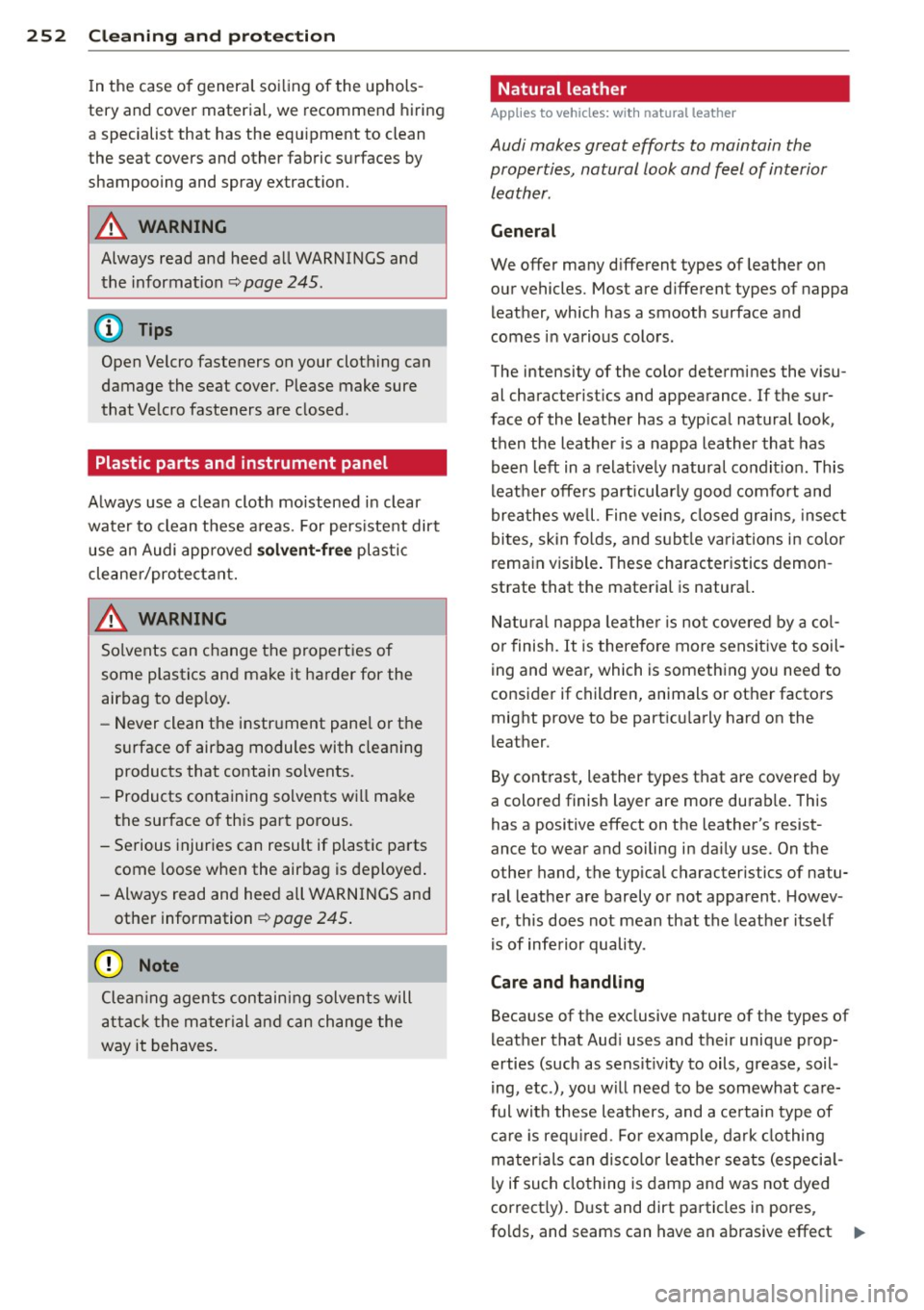
252 Cleaning and protec tio n
In the case of genera l soi ling of the uphols
tery and cover material, we re commend hiring
a specialist that has the equ ipment to clean
the seat cove rs an d other fa bric surfaces by
shampooing and spray ex traction.
.&_ WARNING
Always r ead and heed all WARNINGS and
the information
~ page 245.
(D Tips
Open Velcro fasteners on your clothing can
damage the seat cover. Please make sure
that Velcro fasteners are closed.
Plastic parts and instrument panel
Always use a clean cloth mo istened in clear
wate r to clean these areas. For pers istent dirt
use an Audi approved
s olvent -fr ee plas tic
cleane r/pro tectan t.
.&_ WARNING
So lvents can change the propert ies of
some plastics and make it harder for the
airbag to dep loy.
-
- Never clean the instr ument pane l or the
s u rface of air bag modules with cleaning
products that contain solvents .
- Products conta ining solvents wi ll make
the surface o f th is part porous.
- Serious injuries can result if plastic pa rts
come loose when the airbag is deployed .
- Always read and heed all WARN INGS and
other information ~
page 245.
(D Note
Cleaning agents con taini ng solvents will
at tac k t he mater ial and can change the
way it behaves .
Natural leather
Applies to vehicles: wit h natural leather
Audi makes great efforts to maintain the
properties, natural look and feel of interior
leather .
General
We offer many d ifferent types of leather on
o u r vehicles. Most are d ifferent types of nappa
leather, which has a smooth surface and
comes in various colo rs .
The intensity of the co lo r determines the visu
al characterist ics and appearance .
If the sur
face of the leather has a typ ica l natural look,
then the leather is a nappa leather that has
been left in a relat ive ly natura l condit ion. This
l eat her offe rs part icular ly good comfort and
breathes we ll. Fine veins, closed grai ns, insect
bi tes, sk in fo lds, and s ubtl e va ria tions in color
remain visible . These characteristics demon
strate that the material is natura l.
Natu ra l na ppa le athe r is not covere d by a co l
o r finish. It is therefore mo re sensit ive to soil
ing and wea r, which is something you need to
consider if children, animals or other factors
mig ht prove to be part icu larly hard on the
leat her.
By cont rast, leather types that are covered by
a colo red finish layer are more durable . This
has a positive effect on the leather's resist
ance to wear and soiling in dai ly use. On the
other hand, the typica l characteristics of natu
ral leather a re barely or not apparent . Howev
er, th is does not mean that the leathe r itse lf
i s of infe rior quality .
Care and handling
Because of the exclusive nature of the types of
leather that Aud i uses and their unique prop
erties (such as sens it ivity to oils, grease, soil
i ng, etc.), you will need to be somewhat ca re
ful with these leathers, and a ce rtai n type of
ca re is req uired. Fo r example, dark clothing
ma ter ials can dis co lor le athe r seats (especi al
ly if such clothing is damp and was not dyed
correct ly). Dust and dirt particles in pores ,
fo lds, and seams can have an abrasive effect .,..
Page 255 of 348
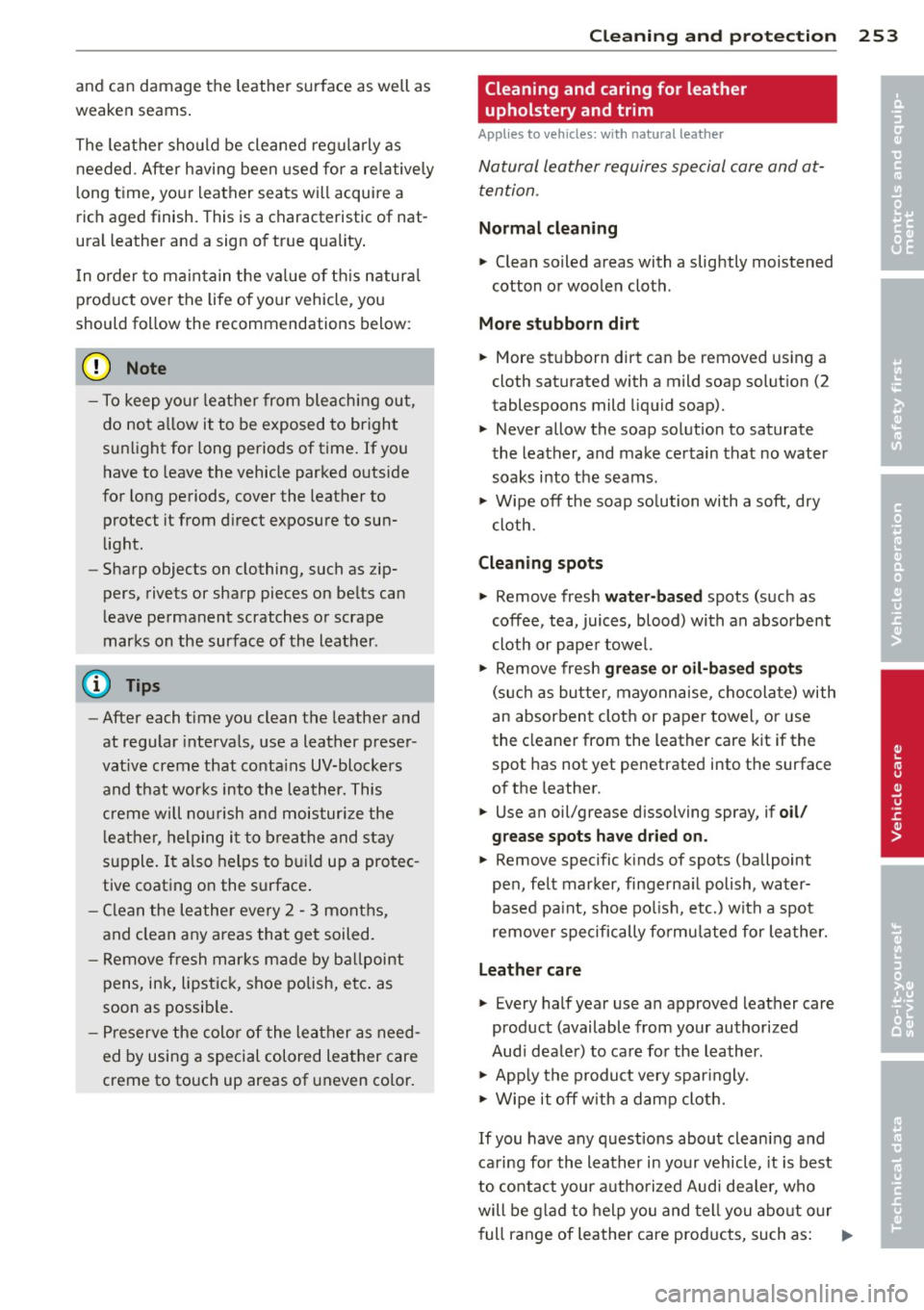
and can damage the leather surface as well as
weaken seams .
The leather sho uld be cleaned reg ularly as
needed. After having been used for a re latively
l ong time, yo ur leather seats will acquire a
rich aged finish. This is a characteristic of nat
ura l leather and a sign of true quality .
I n o rder to maintain the va lue of th is natura l
p roduct over the life of your vehicle, you
should follow the recommendations below :
(D Note
-To keep yo ur leather from bleach ing out,
do not a llow it to be exposed to bright
sunlight for long periods of time. If you
have to leave the vehicle parked o utside
for long periods, cover the leather to
protect it from d irect exposure to sun
light.
- Sharp objects on clothing, such as zip
pers, rivets or sharp pieces on be lts can
leave permanent scratches or scrape
marks on the surface of the leather .
- After each time you clean the leather and
at regu lar inte rva ls, use a leather preser
vat ive creme that conta ins UV-blockers
and that wor ks into the leather. This
c reme will no urish and moistur ize the
l eather, helping i t to brea the and stay
supple .
It also helps to b uild up a protec
tive coating on the s urface .
- Clean the lea ther every 2 -3 months,
and clean any areas that get soiled.
- Remove fresh mar ks made by ba llpoint
pens, ink, lipstick, shoe polish, e tc. as
soon as possib le .
- Preserve the colo r of the lea ther as need
ed by using a special colored leather care
creme to to uch up areas of uneven co lor.
Cleaning and protec tion 253
Cleaning and caring for leather
upholstery and trim
App lies to vehicles : with natural lea ther
Natural leather requires special care and at
tention .
Normal cleaning
.. Clean so iled areas with a slightly moistened
cotton or woolen cloth .
More stubborn dirt
.. More st ubborn dirt can be removed using a
cloth saturated with a mild soap solut ion (2
tablespoons mild liquid soap).
.. Never allow the soap solution to saturate
the leather, and make certain that no water soaks into the seams.
.,. Wipe off the soap so lution with a soft, dry
cloth.
Cleaning spots
.. Remove fresh wat er-based spots (such as
coffee, tea, juices, blood) with an absorbent
cloth or pape r towel.
.. Remove fresh
greas e or oil-ba sed spot s
(such as bu tte r, mayonnaise, chocola te) with
an absorbent cloth or paper towel, or use
the cleaner from the leather care kit if the
spot has not yet penetrated into the surface
of the leather.
.. Use an oil/grease dissolving spray, if
oil/
grease spot s ha ve dried on.
.. Remove specific k inds of spots (ballpoint
pen, felt marker, fingerna il polish, water
based pa int, shoe po lish, etc.) with a spot
remover specifically fo rmu lated for leather.
Leather care
.. Every half year use an approved leather care
product (available from your authorized
Aud i dealer) to care fo r the leather.
.,. App ly the product very spar ingly.
.. Wipe it off with a damp clot h.
If you have any questions about clean ing and
ca ring for the leather in your v ehicle, it is best
to contact you r authorized Audi dea ler, who
will be g lad to help you and tell you abo ut o ur
f ull range of leather care products, such as : .,..
•
•
Page 256 of 348
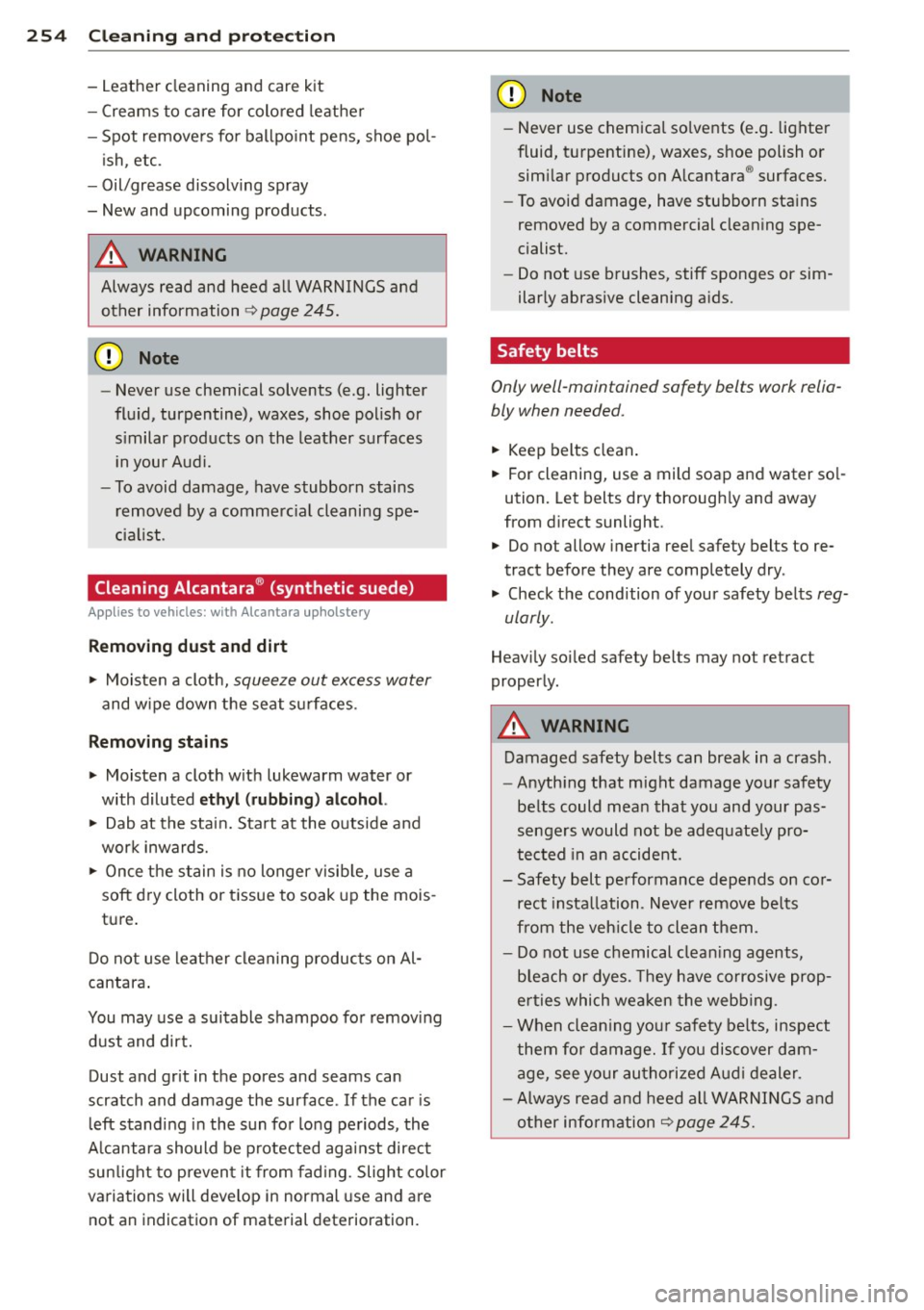
254 Cleaning and protec tio n
- Leather cleaning and care kit
- Creams to care for colored leather
- Spot removers for ballpo int pens, shoe pol-
ish, etc .
- Oil/grease dissolving spray
- New and upcoming products.
A WARNING
Always read and heed all WARNINGS and
other information
~ page 245.
{[) Note
-Never use chemical solvents (e.g. lighter
fluid, turpentine), waxes, shoe pol ish or
s imilar products on the leather surfaces
i n your Audi.
- To avoid damage, have stubborn stai ns
removed by a commerc ial cleaning spe
cia list.
Cleaning Alcantara ® (synthetic suede)
App lies to vehicles : wit h Alca nta ra up holstery
Removing dust and dirt
"" Moisten a clot h, squeeze out excess water
and w ipe down the seat s urf aces.
Removing stains
"" Moisten a clot h w ith lukewarm water or
with diluted
ethyl (rubb ing) alcohol.
"" Dab at the stain. Start at the o utside and
wor k inwards.
"" Once t he stain is no longer v isib le , use a
soft dry cloth or t issue to soak up the mois
ture .
Do not use leather cleaning produc ts on Al
cantara .
You may use a suitable shampoo fo r removing
dust and dir t.
Dust and grit in the pores and seams can
scratch and damage the surface .
If the car is
l eft stand ing in the sun fo r long pe riods, the
A lcantara should be p rotected aga inst direc t
sun light to prevent it from fad ing. Slight color
variations will develop in normal use and are
not an indication of material deterioration.
(D Note
- Never use chemica l so lvents (e.g. lighte r
fluid, tu rpentine), waxes, s hoe polish or
sim ilar products on A lcantara® surfaces.
- To avoid damage, have stubbo rn stains
removed by a commercial clean ing spe
cialist.
- Do not use b rushes, stiff sponges or sim
ilar ly abrasive cleaning a ids.
Safety belts
Only well-maintained safety belts work relia
bly when needed.
"" Keep belts clean .
"" For cleaning, use a mild soap a nd water so l
ution. Let belts dry thorough ly and away
from d irect sunlight .
"" Do not allow inertia ree l safety belts to re
tract before they are completely dry.
"" Check the condition of your safety be lts
reg
ularly.
Heavily soiled safety belts may not retract
properly.
A WARNING
D amaged safety belts can break in a crash .
- Anyth ing that might damage your safety
be lts could mea n that you and your pas
sengers would not be adequate ly pro
tec ted in a n accident.
- Safety belt performance depends on co r
rect insta llation. Neve r remove be lts
from the veh icle to clean them.
- Do not use chemical clean ing agents,
b leach or dyes. They have corrosive prop
erties which wea ken the webb ing.
- When clean ing you r safety belts, inspect
them for damage. If you discover dam
age, see yo ur authorized A udi dealer.
- Always read and heed a ll WAR NINGS and
other info rmation
~ page 245.
Page 257 of 348
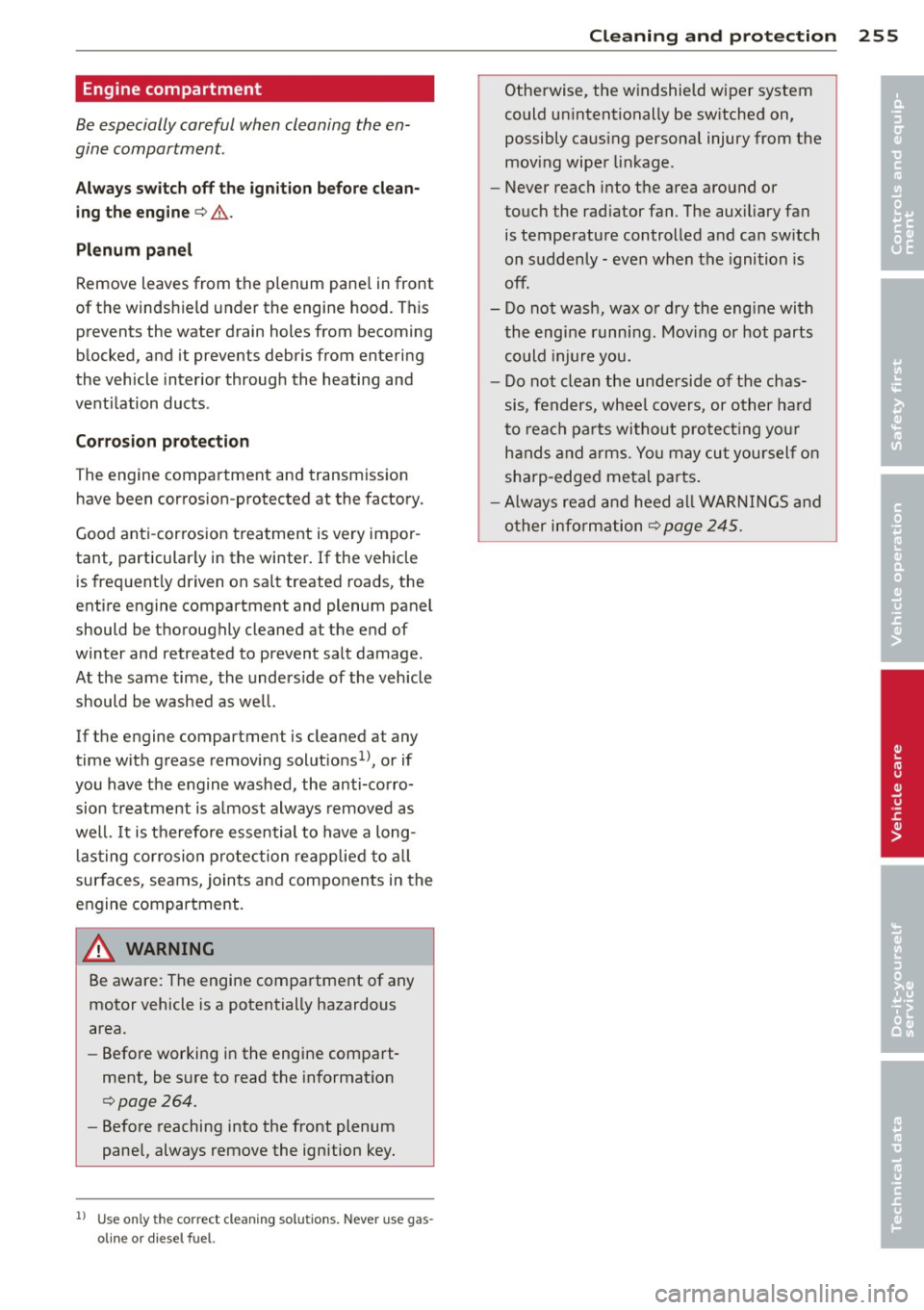
Engine compartment
Be especially careful when cleaning the en
gine compartment.
Al ways s witch off the ign ition befor e clean
ing the eng in e
c:> & .
Plenum panel
Remove leaves from the plenum pane l in front
of the windshield under the engine hood. This
prevents the water drain holes from becoming
blocked, and it prevents debris from entering
the vehicle interior through the heating and
ventilation ducts .
Corrosion protecti on
The engine compartment and transmission
have been corrosion-protected at the factory.
Good anti-corrosion treatment is very impor
tant, particular ly in the winter . If the vehicle
is frequent ly driven on salt treated roads, the
entire engine compartment and plenum panel
should be thoroughly cleaned at the end of
winter and retreated to prevent sa lt damage.
At the same time, the underside of the vehicle
should be washed as we ll.
If the engine compartment is cleaned at any
time with grease removing solut ions
1>, or if
you have the engine washed, the anti-corro
sion treatment is a lmost always removed as
well.
It is therefore essential to have a long
lasting co rrosion protection reapp lied to a ll
surfaces, seams, joints and components in the
engine compartment.
A WARNING
Be aware: The engine compa rtment of any
motor vehicle is a potentially hazardous
area.
- Before working in the engine compart
ment, be s ure to read the in format ion
c:> page 264.
- Before reaching into the front plenum
pane l, always remove the ignition key.
l) Use only the correct cleaning sol utions. Never use gas
oline or diesel fuel.
Cleaning and protec tion 255
Otherwise, the windshield wiper system
could un intentionally be switched on,
possibly caus ing personal injury from the
mov ing wiper linkage.
- Never reach into the area around or
touch the radiator fan. The aux iliary fan
is temperature controlled and can sw itch
on suddenly - even when the ignition is
off.
- Do not wash, wax or dry the eng ine with
the engine running. Moving or hot parts could injure you.
- Do not clean the underside of the chas
sis, fenders, wheel covers, or other ha rd
to reach pa rts without protect ing your
hands and arms. You may cut yourself on
sharp-edged metal parts .
- Always read and heed all WARNINGS and
o ther info rmation
c:> page 245.
•
•
Page 258 of 348
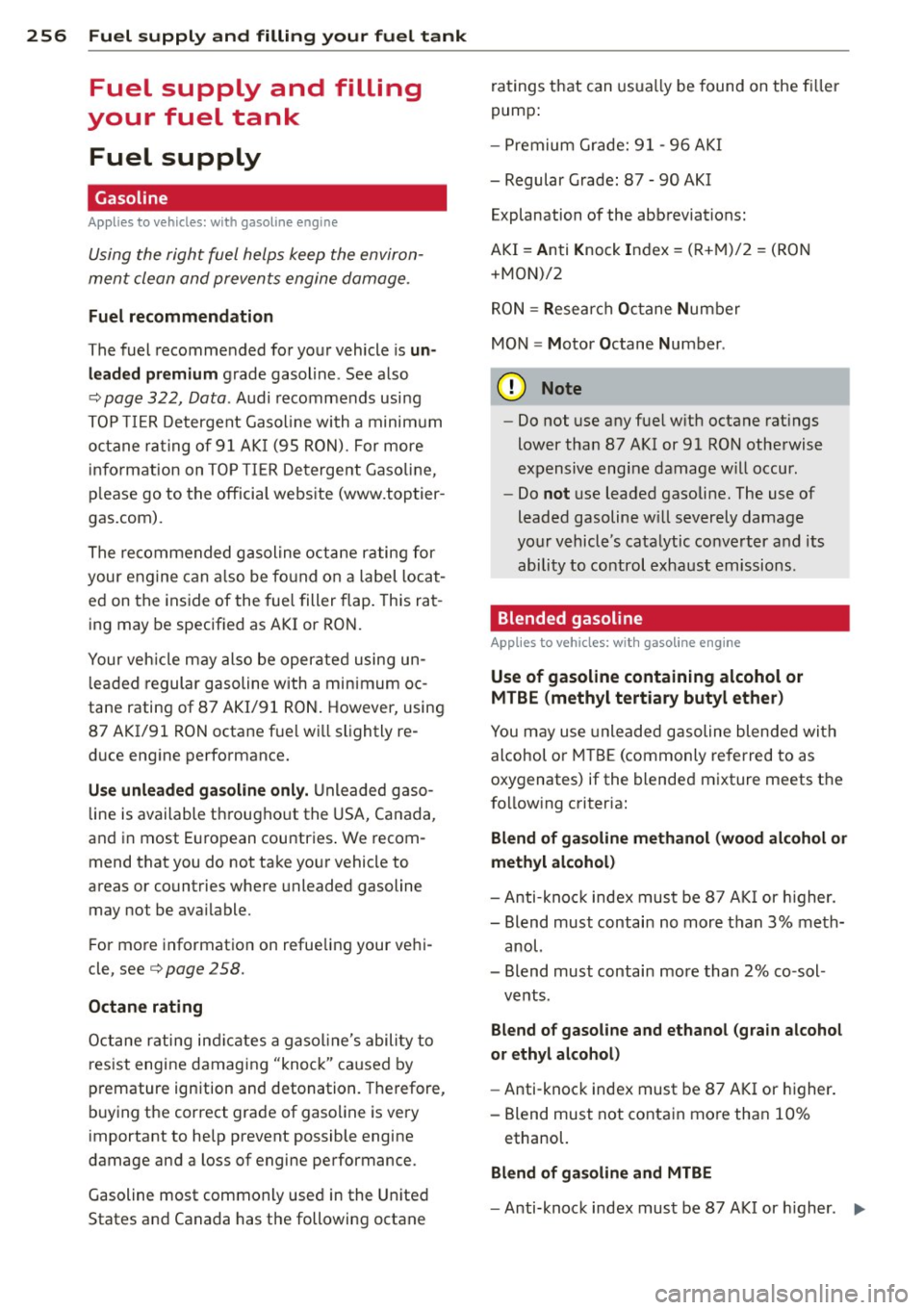
256 Fuel supply and filling your fuel tank
Fuel supply and filling
your fuel tank
Fuel supply
Gasoline
Appl ies to vehicles: with gasoline engine
Using the right fuel helps keep the environ
ment clean and prevents engine damage .
Fuel recommendation
The fuel recommended for yo ur vehicle is un
lead ed premium
grade gasolin e. See a lso
¢ pag e 322, Data . Audi recommends usi ng
T OP TIE R Detergent Gaso line wi th a minim um
o ct ane rating of 9 1 AKI (95 RON). For more
i nf ormat ion on TO P TI ER De tergent Gaso line,
p lease go to t he officia l webs ite (www.toptier
gas.com).
T he re commended g asoline octa ne r ating for
your engine can a lso be fo und on a la bel locat
e d on the inside of the fue l filler flap . This ra t
ing may be specif ied as A KI or RO N.
Your veh icle m ay also be oper ated using un
l eaded regular gasoline with a minimum o c
tane rating of 87 AKI/91 RO N. However, using
87 AKI/91 RON octa ne fue l w ill slightly re
d uce engine performance.
Use unleaded gasoline only. Unleaded gaso
line is available th rougho ut the USA, Ca nada ,
and i n most E uropean countries . We recom
mend that you do not ta ke yo ur vehicle to
areas or count ries w here unleaded gasoline
may not be available.
F or mo re informat io n on refue ling your ve hi
cle, see
¢ page 258.
Octane rating
Octa ne r ating ind icates a gaso line's abili ty to
res ist engine damagin g "knoc k" ca use d b y
p remature ign ition and detonation. Therefore,
buy ing the correct grade of gaso line is very
important to help prevent possible engine
damage and a loss of engine performance.
Gasoline most commonly used in the Unite d
States and Canada has t he following octane r
atings t hat can usu a lly be found on the fi ller
p ump:
- Premium Gra de: 91 -9 6 A KI
- Regular Grade : 87 -90 AKI
Explanation of the abbreviations:
AKI = Anti Knock In d ex = (R+M) /2 = (RO N
+ MON)/2
R ON= Resea rch Octane Number
MON = Motor Octane Num ber.
(D Note
- Do not use a ny fue l w it h octane rat ings
lower tha n 87 A KI or 91 RO N othe rwise
e xpensive engine damage w ill occur.
- Do
not use leaded gasoline. The use of
leaded gasoline w ill severely damage
yo ur v ehicl e's cata lytic co nve rter a nd its
abi lity to co ntrol exha ust em issions .
Blended gasoline
Applies to vehicles: with gasoline engine
Use of gasoline containing alcohol or
MTBE (methyl tertiary butyl ether )
You may use unleaded g asoline blende d wi th
alcohol o r MTBE (commonly referred to as
oxygenates) if the blende d mixture meets t he
f o llow ing criteria:
Blend of gasoline methanol (wood alcohol or
methyl alcohol)
- Anti -kno ck index must be 87 A KI or higher.
- Blend must contain no more t han 3% meth-
anol.
- Blend must contain more than 2% co -sol -
vents.
Blend of gasoline and ethanol (grain alcohol
or ethyl alcohol)
- Anti -knock index must be 87 AKI or higher .
- Blend must not conta in mo re tha n 10%
ethanol.
Blend of ga soline and MTBE
- Anti-knoc k index mus t be 87 AKI or higher. IJll,
Page 259 of 348
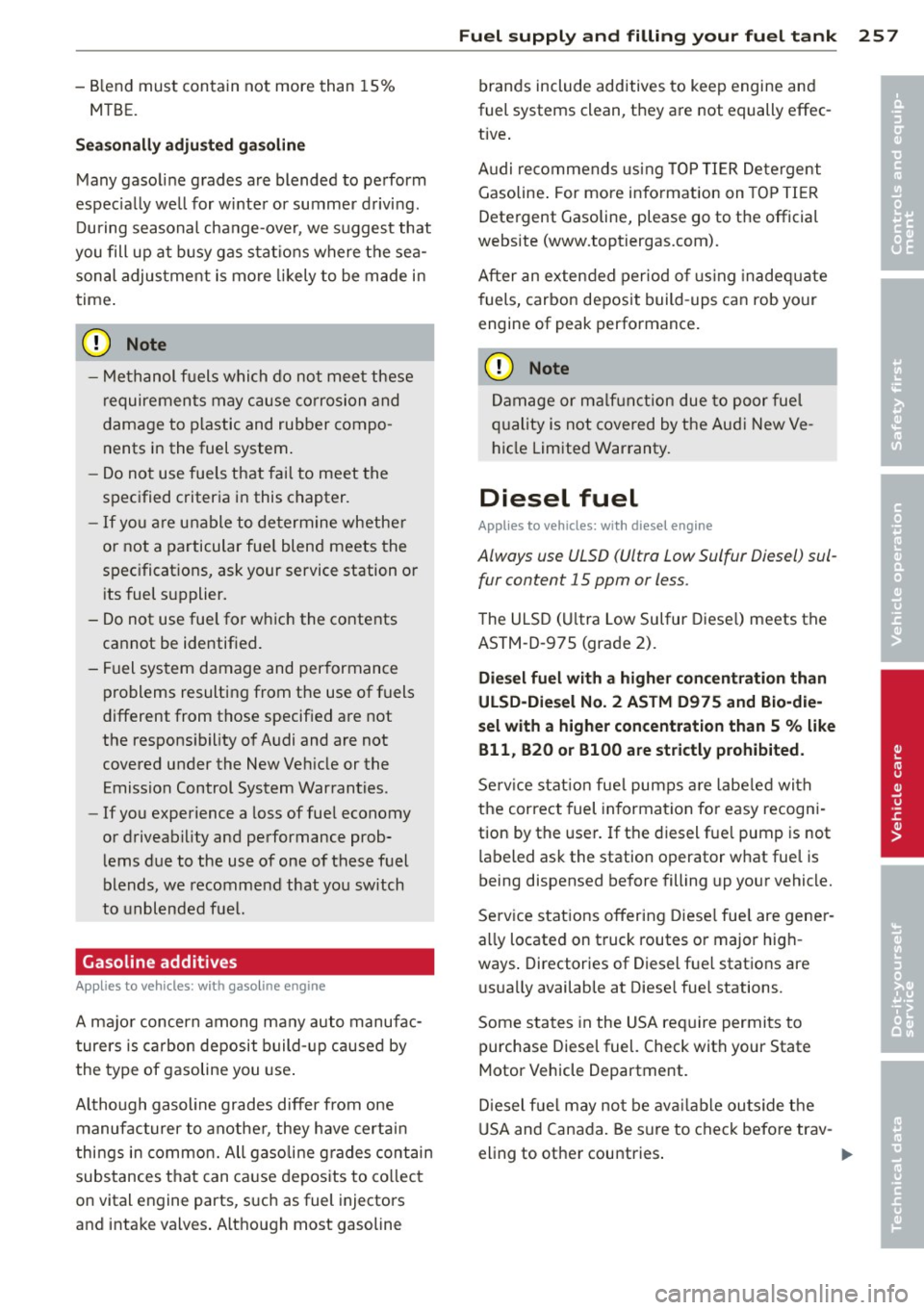
-Blend must contain not more than 1S%
MTBE.
Seasonally adjusted gasoline
Many gasoline grades are blended to perform
espec ially we ll for winter or summer driving.
During seasonal change-over, we suggest that
you fill up at busy gas stat ions where the sea
sonal adjustment is more likely to be made in
time .
(D Note
-Methanol fuels which do not meet these
requirements may cause corrosion and
damage to plastic and rubber compo
nents in the fuel system.
- Do not use fue ls that fail to meet the
specified criter ia in this chapter.
- If you are unable to determine whether
or not a particular fue l blend meets the
specifications, ask your service station or
its fuel supp lier.
- Do not use fuel for which the contents
cannot be identified.
- Fuel system damage and performance
problems resulting from the use of fuels
different from those specified are not
the responsibility of Audi and are not
covered under the New Vehicle or the Emission Control System Warranties.
- If you experience a loss of fuel economy
or driveability and performance prob l ems due to the use of one of these fuel
blends, we recommend that you switch
to unblended fuel.
Gasoline additives
Applies to vehicles : wit h gasoli ne e ng in e
A majo r concern among many auto manufac
ture rs is carbon deposit build-up caused by
the type of gasoline you use.
Although gasoline grades differ from one manufacturer to another , they have certain
things in common. All gasoline g rades contain
substances that can cause deposits to collect
on vital engine parts, such as fuel injectors
and intake valves. Although most gasoline
Fuel supply and filling your fuel tank 257
brands include additives to keep engine and
fuel systems clean, they are not equally effec
tive .
Audi recommends using TOP TIER Detergent
Gasoline . For more information on TOP TIER
Detergent Gasoline, please go to the official
webs ite (www.toptiergas.com).
After an extended per iod of using inadeq uate
fuels, carbon deposit build-ups can rob your
engine of peak performance.
(D Note
Damage or malf unct ion due to poor fuel
quality is not covered by the Audi New Ve
hicle Limited Warranty.
Diesel fuel
Applies to veh icles: w ith diesel engine
Always use ULSD (Ultra Low Sulfur Diesel) sul
fur content 15 ppm or less.
The ULSD (U ltra Low Sulfur Diesel) meets the
ASTM-D-97S (grade 2).
Die sel fuel with a higher concentration than
ULSD-Die sel No. 2 ASTM D975 and Bio-die
sel with a higher concentration than 5
% like
Bl 1 , B20 or B100 are strictly prohibited.
Service station fue l pumps are labeled with
the correct fuel information for easy recogni
tion by the user. If the diesel fuel pump is not
labeled ask the station operator what fuel is
being dispensed before filling up your vehicle.
Serv ice stations offering Diesel fuel are gener
ally located on truck routes or major high
ways . Directories of Diesel fuel stations are
usually available at Diese l fuel stations.
Some states in the USA require permits to
purchase Diesel fuel. Check with your State
Motor Vehicle Department .
Diesel fuel may not be available outside the
USA and Canada. Be sure to check before trav-
eling to other countries .
Ill-
•
•
Page 260 of 348
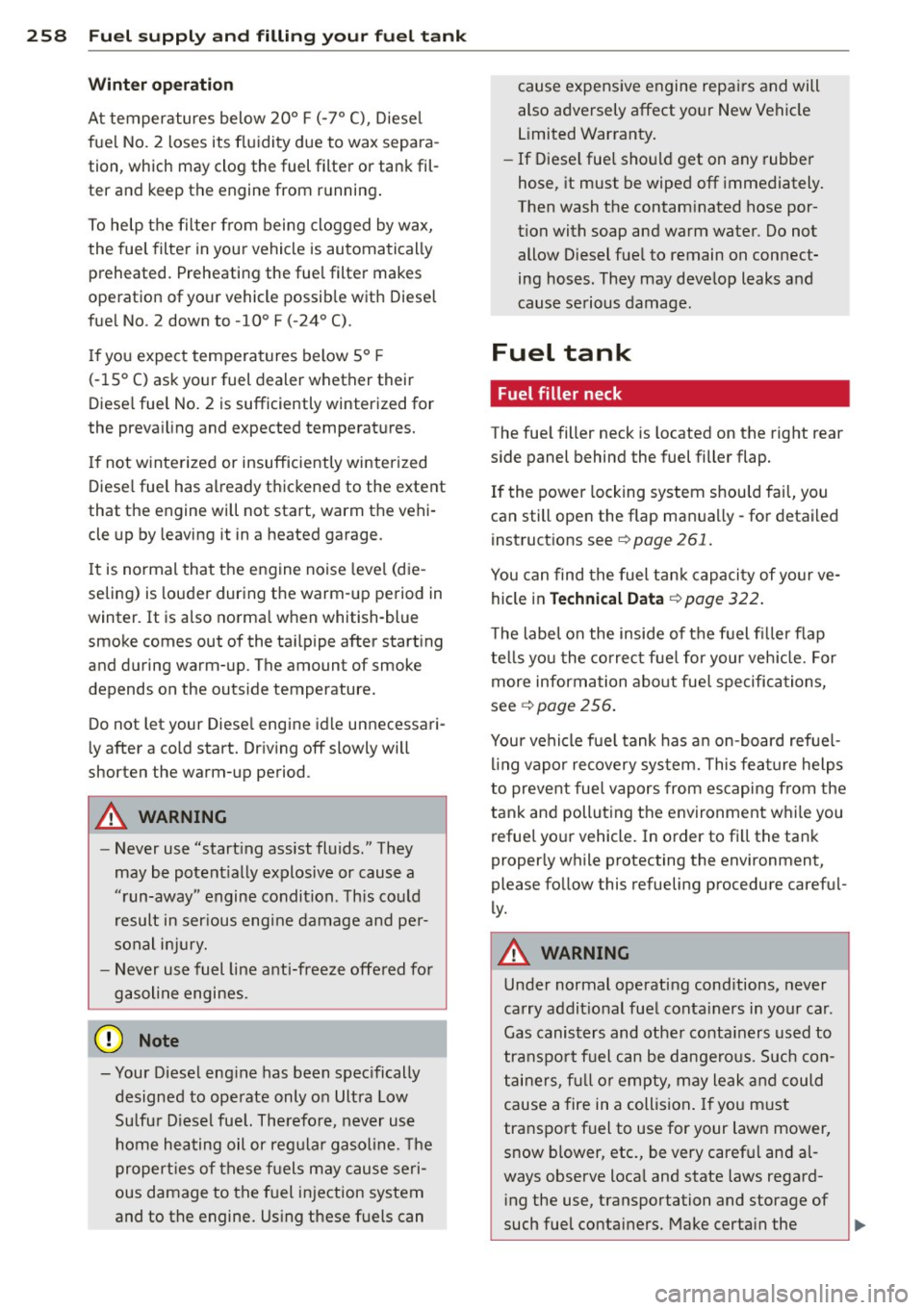
258 Fuel supply and filling your fuel tank
Winter operation
At temperatures below 20° F (-7° C), Diesel
fuel No.
2 loses its fluidity due to wax separa
tion, which may clog the fuel filter or tank fil
ter and keep the engine from running .
To help the filter from being clogged by wax,
the fue l filter in your vehicle is automatically
preheated. Preheating the fuel filter makes
operation of your vehicle possible with Diesel
fuel No. 2 down to -10° F (-24° C).
If you expect temperatures below
5° F
(-15° C)
ask your fuel dealer whether their
Diese l fuel No.
2 is sufficiently winterized for
the prevailing and expected temperatures.
If not winterized or insufficiently winterized
Diesel fuel has already thickened to the extent
that the engine will not start, warm the vehi
cle up by leaving it in a heated garage.
It is normal that the engine noise leve l (die
seling) is louder during the warm-up period in
winter. It is also norma l when whitish-blue
smoke comes out of the tailpipe after starting
and during warm-up . The amount of smoke
depends on the outs ide temperature.
Do not let your Diese l engine idle unnecessari
ly after a cold start. Driving off slowly will
shorten the warm-up period.
A WARNING
- Never use "starting assist fluids." They
may be potent ially explosive or cause a
"run-away" engine condition. This could
result in ser ious engine damage and per
sonal injur y.
- Never use fuel line anti-freeze offered for
gasoline engines.
(D Note
- Your Diesel engine has been specifically designed to operate only on Ultra Low
Sulfur Diesel fuel. Therefore, never use
home heating oil or regular gasoline. The
properties of these fuels may cause seri
ous damage to the fuel injection system
and to the engine. Using these fuels can
-
cause expensive engine repairs and will
also adversely affect your New Vehicle
Limited Warranty.
- If Diesel fuel sho uld get on any rubber
hose, it must be wiped off immediately.
Then wash the contaminated hose por
tion with soap and warm water. Do not allow D iesel fuel to remain on connect
ing hoses . They may develop leaks and
cause serious damage.
Fuel tank
Fuel filler neck
The fuel filler neck is located on the right rear
side panel behind the fuel filler flap.
If the power locking system shou ld fail, you
can still open the flap manua lly -for detailed
instructions see ¢
page 261.
You can find the fuel tank capacity of your ve
hicle in
Technical Data ¢page 322 .
The label on the inside of the fuel filler flap
te lls you the correct fuel for your vehicle. For
more information about fuel specifications,
see ¢
page 256.
Your vehicle fuel tank has an on-board refuel
ling vapo r recovery system. This feature helps
to prevent fue l vapors from escaping from the
tank and polluting the environment while you refuel your vehicle. In order to fi ll the tank
proper ly while protecting the environment,
please fo llow this refueling procedure careful
ly.
A WARNING
-Under normal operating conditions, never
carry addit ional fuel conta iners in your car .
Gas canisters and other conta iners used to
transport fuel can be dangerous. Such con
tainers, full or empty, may leak and could
cause a fire in a collision.
If you must
transport fuel to use for your lawn mower,
snow blower, etc., be very careful and al
ways observe loca l and state laws regard
ing the use, transportation and storage of
such fuel containers. Make certain the ..,.